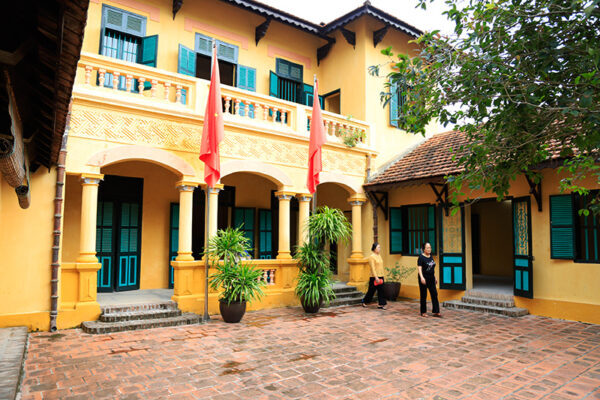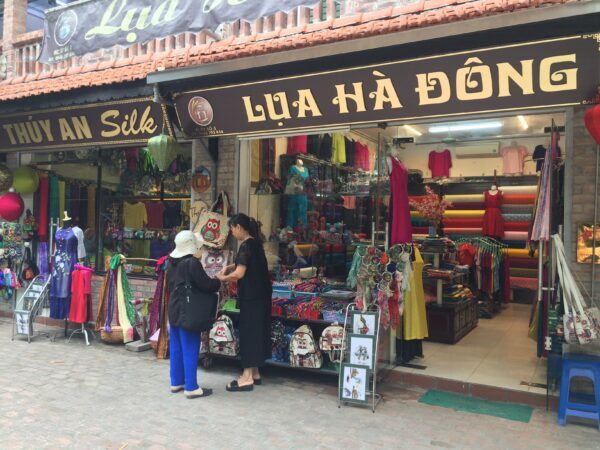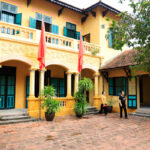
President Ho Chi Minh memorial house in Van Phuc village attracts many visitors every year.
At the end of 1946 when preparing for the resistance war against the French colonialist, the Central Committee secretly took Uncle Ho to Mr. Nguyen Van Duong’s house in Van Phuc village. Because Mr. Duong had a large silk weaving workshop where many traders and customers came in and out, the fact of Uncle Ho’s stay would not be revealed. Besides, Mr. Duong also regularly participated in many revolutionary works. That’s why Mr. Duong’s house was chosen to be Uncle Ho’s living and working place for 16 days from December 3 to December 19, 1946). During His time here, Uncle Ho, along with the leaders of the Party and Government, dealt with critical revolutionary tasks. On December 18 and 19, 1946, He presided the expanded Central Party’s Standing Meeting and launched the nation-wide resistance war against the French colonialist. The basic guideline and motto of the resistance war outlined at the Meeting were set out in the Party’s Directive “Nation-wide Resistance War”. The Meeting also adopted the “Call for the nation-wide resistance war” made by President Ho Chi Minh. Immediately after the Meeting, on the evening of December 19, 1946, “Call for nation-wide resistance war” was launched, calling all Vietnamese people to fight against and get rid of the invading French colonialist. It was also the inspiration and motivation for the Vietnamese army and people during 9 years of the resistance war, contributing to the glorious Dien Bien Phu victory.
The house of Mr. Nguyen Van Duong – where Uncle Ho lived and worked during His time in Van Phuc became President Ho Chi Minh Memorial House and was ranked by the Ministry of Culture and Information (currently known as the Ministry of Culture, Sports and Tourism) as National Historic Site in 1975. This three-compartment, two-storey house has been preserved as the main area of the memorial house. On the right and left of the house are two horizontal blocks, in which looms and household appliances were placed previously, and now the floor and ceiling of the blocks have been repaired and upgraded. The living room on the right block is used as a place to welcome domestic and international people and visitors. The gallery of revolutionary traditions of the Party Committee and the people of Van Phuc is on the left block. The second floor of the house is maintained as it was when Uncle Ho lived and worked: the small room on the left with a simple wooden bed, a wooden pillow painted in red, a desk next to the bed, with a hurricane lamp and manuscript page “Call for nation-wide resistance war”. President Ho Chi Minh memorial house welcomes many visitors every year and becomes the “red address” for revolutionary traditional education for the young generation.

Van Phuc develops the traditional long-lasting silk weaving profession.
Proud to be the living and working place of Uncle Ho for a time, over the past 70 years, Van Phuc people have made their homeland increasingly rich, beautiful and civilized. Despite today’s fast urbanization rate of Van Phuc, its cultural and revolutionary historical values have always been maintained. Thanks to the talent, elegance, ingenuity and creativity of silk villagers, the traditional long-lasting silk weaving profession of Van Phuc has still been preserved. From a poor village, Van Phuc became an economically developed ward of Ha Dong district. At the present, Van Phuc welcomes dozens of domestic and international tourists every day. To improve the production value of a craft village and attract tourists, Van Phuc installed a signboard of providing craft village services; completed a high-quality craft village product business center; has combined sightseeing and shopping at the craft village with visiting the memorial house, communal houses, pagodas, and Phuong Cui; organized Van Phuc craft village tourism and culture week, etc., contributing to making Van Phuc a typical area of “craft village – revolutionary village – cultural tourist village” in Hanoi capital.
Mai Phuong

